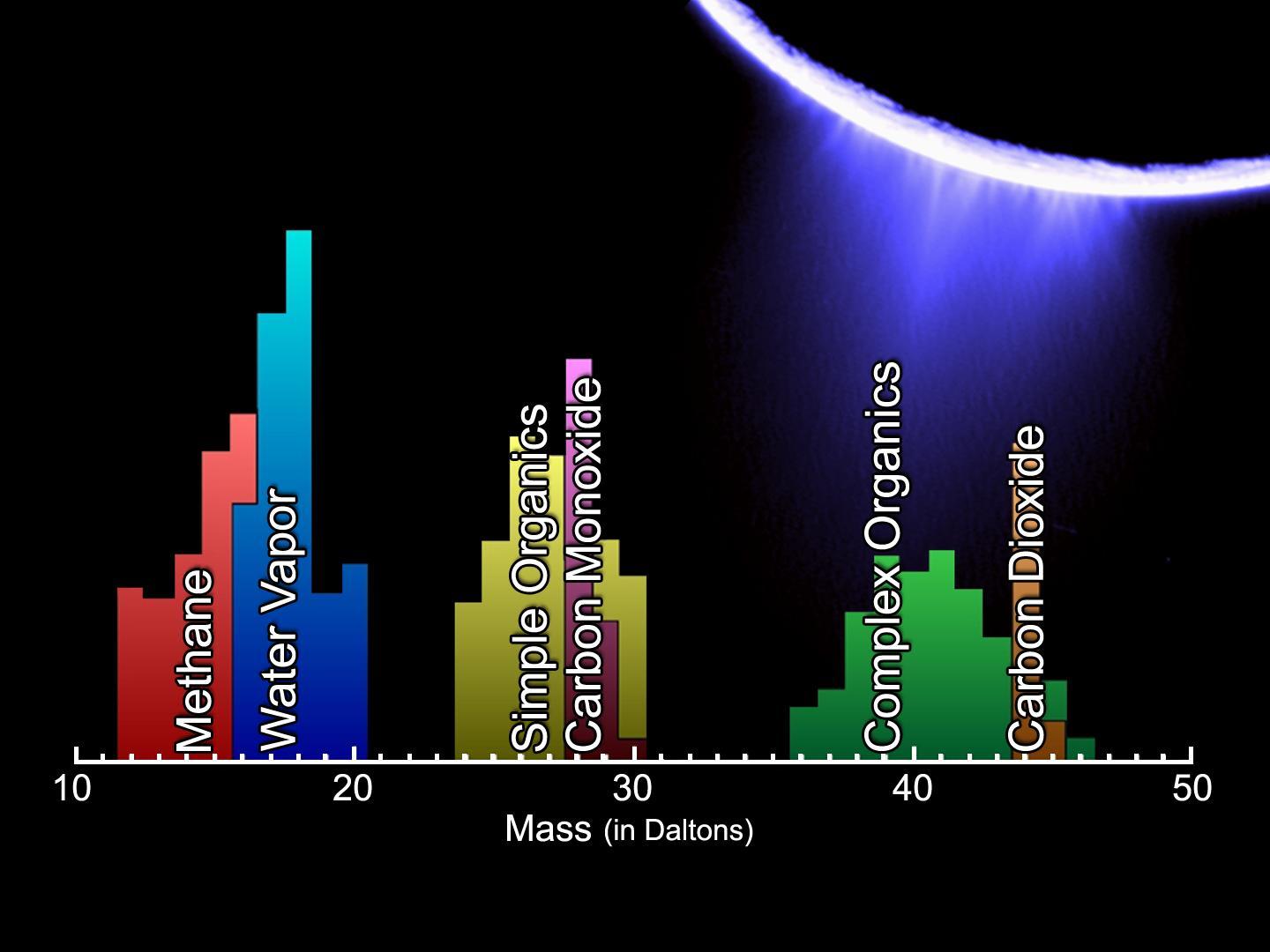PIA10356 shows the chemical constituents sampled in Enceladus' plume by Cassini's Ion and Neutral Mass Spectrometer during its fly-through of the plume.
See
Volume 1-Mission Overview, Science Objectives and Results for full science report. The technical report is in other volumes archived at the Jet Propulsion Lab.
Mission Science Highlights and Science Objectives Assessment provides a brief overview of the mission
About INMS
The Ion and Neutral Mass Spectrometer (INMS) was capable of determining the molecular, elemental and isotopic composition of the gaseous and volatile components of neutral particles and low energy ions in key regions of the Saturn system under the constraints of inherent sensitivity and mass resolution. The primary focus of the INMS was on Titan's upper atmosphere and its interaction with the surrounding magnetospheric plasma. However, two other serendipitous targets of note are Enceladus and Saturn’s equatorial region. The instrument accomplished these measurements with its open ion source (reactive ions and neutrals), closed ion source (neutrals only) and quadrupole mass analyzer and deflector. INMS' construction was the result of a collaboration between NASA's Goddard Space Flight Center and the University of Michigan.
Scientific objectives for the INMS include the following:
- Measure the ion and neutral species composition and structure in the upper atmosphere of Titan
- Study Titan's atmospheric chemistry
- Investigate the interaction of Titan's upper atmosphere with the magnetosphere and solar wind
- Measure the ion and neutral species compositions during ring plane crossings and icy satellite flybys
- Measure volatile compounds from Enceladus’ plumes representative of ocean chemistry
- Measure the infall of material from the rings and its chemical effects on Saturn’s equatorial atmosphere and ionosphere
INMS modes:
- Closed-Source Neutral: Non-reactive Neutrals
- Open-Source Ion (OSI): Positive ions < 100 eV
- Open-Source Neutral: Reactive Neutrals
INMS Instrument Characteristics
| General Characteristics |
|
|
|
| Mass Range (Daltons) |
1–8, 12–99 |
| Sample Period (ms) |
31.1 (integration); 34.0 (total) |
|
Closed Source
| Open Source
|
| Sampling System |
Non-reactive Neutrals |
Reactive Neutrals and Ions |
| Viewing Angle |
~2π steradians
Teolis et al., 2015 |
2-3º (cone half-angle)
Updated since Waite et al., 2004 |
Minimum Source Density
(particles/cm3) |
Perry et al., 2010 in J. Geophys. Res. |
Waite et al., 2017 Science paper supplement |
| Sensor Sensitivity |
Link to PDS Calibration file w/ updates in Teolis et al., 2015 |
|---|
INMS was typically operated in one of three different modes: a closed source neutral mode, an open source neutral mode,
or an open source ion mode. The closed source neutral mode, which measured non-reactive neutrals
such as N2 and CH4, was the most sensitive of the three. It was capable of detecting concentrations on the order of ≥104 cm-3. The open source
neutral mode, in which the instrument detects reactive neutrals like atomic nitrogen, made measurements at concentrations two orders of magnitude higher, ≥106 cm-3. The open source ion mode was used to measure positive ions with energies less than 100 eV. The detection threshold in the open source ion mode was ~10-2 cm-3 at a velocity of 6 km/s relative to Titan. INMS detected masses between 1-99 Daltons with a mass resolution M/ΔM of 100 at 10% of mass peak height, sufficient for the detection of heavier organic species and cyclic organics like C6H6 (with the help of electron impact dissociative ionization and mass deconvolution techniques).
The engineering details of the INMS instrument and the science objectives it was built to address are described in further detail in the
Space Science Reviews paper by
Waite et al. (2004). Users may also find the 2015
Space Science Reviews paper by
Teolis et al. helpful for calibrating data.
INMS Data
The Software Interface Specification Document provides a description on the INMS data
Data Search Tools
Browse Raw Data Products
Derived Data Products
Selecting Data Products
Analyzing INMS Data
Once data products have been selected and retrieved, users will need to read, manipulate and display that data. Resources that will enable users to make use of INMS data are listed below.
 PDS: The Planetary Atmospheres Node
PDS: The Planetary Atmospheres Node
